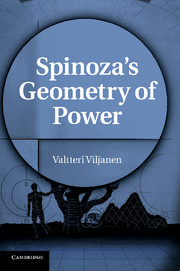Book contents
- Frontmatter
- Contents
- Acknowledgements
- Abbreviations
- Other sources
- Introduction
- Chapter 1 Spinoza on being
- Chapter 2 Causation and geometry
- Chapter 3 Power, existence, activity
- Chapter 4 The derivation of the conatus doctrine
- Chapter 5 The meaning of the conatus doctrine
- Chapter 6 Geometrical dynamics of individuality
- Conclusion
- Bibliography
- Index
Chapter 5 - The meaning of the conatus doctrine
Published online by Cambridge University Press: 07 October 2011
- Frontmatter
- Contents
- Acknowledgements
- Abbreviations
- Other sources
- Introduction
- Chapter 1 Spinoza on being
- Chapter 2 Causation and geometry
- Chapter 3 Power, existence, activity
- Chapter 4 The derivation of the conatus doctrine
- Chapter 5 The meaning of the conatus doctrine
- Chapter 6 Geometrical dynamics of individuality
- Conclusion
- Bibliography
- Index
Summary
There are two competing overall readings of the nature and meaning of the conatus doctrine. Here the issue of teleology draws the line of division: roughly speaking, one approach is for it, the other against. The significant question is, to borrow Steven Nadler’s words, ‘whether or not Spinoza, contrary to what would seem to be the lesson of the Ethics so far, is surreptitiously and (it has been argued) illegitimately introducing teleology into nature’. It seems that the interpretations presented thus far are relatively unproblematically categorizable within either of the two types of approach. In this chapter I consider an extensive array of interpretations, articulate my reasons for finding the two main interpretative outlooks unsatisfactory despite the fact that there is truth in both of them, and offer my own view of the doctrine on which it appears as a focal facet of Spinoza’s geometry of power. I will start by presenting the line of thought in which Spinoza is regarded as the sternest early modern critic of all ends and final causes.
The inertial reading
There is a time-honoured, and I believe dominant, tradition of viewing Spinoza’s system as thoroughly non-teleological in character – a tradition obviously drawing its force largely from the mechanistic tendencies Spinoza displays. Much of the discussion in this section will focus on John Carriero’s recent ‘Spinoza on Final Causality’, because it provides an especially elegant, thorough, and consistent account of this line of interpretation, which I would call inertial, and which in its general orientation has been, at least implicitly, quite popular in scholarship. Carriero approaches Spinoza as a proponent of the mechanical philosophy: ‘He [Spinoza] presents a theory according to which the sort of causality the new scientists find in the corporeal order is found throughout all of nature.’ Moreover, a similar attitude to interpreting Spinoza is explicitly endorsed by such contemporary scholars as Jonathan Bennett and Lee Rice, whose views I will also discuss.
- Type
- Chapter
- Information
- Spinoza's Geometry of Power , pp. 105 - 144Publisher: Cambridge University PressPrint publication year: 2011



